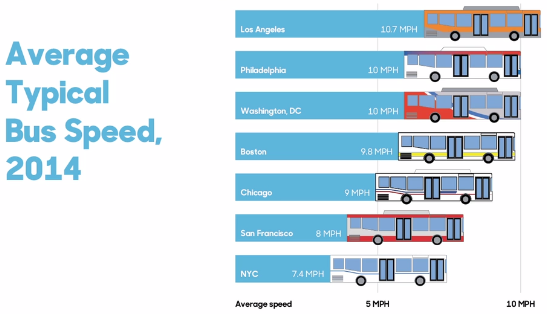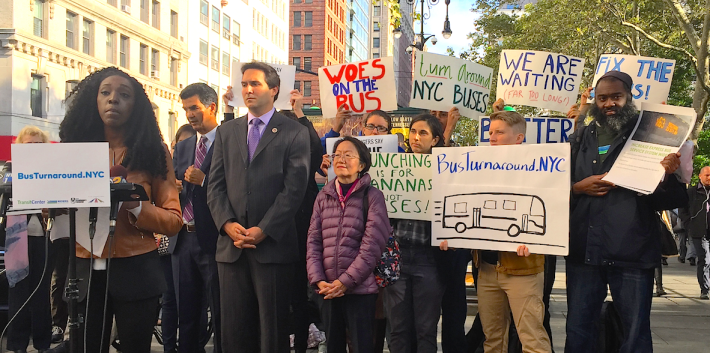
Bus ridership in New York City has steadily declined since 2002, and bus riders put up with the slowest average speeds in the nation. But the MTA is in no hurry to fix the problem.
At a City Council hearing this morning, MTA representatives touted the agency's piecemeal efforts to improve bus service while pushing back against recommendations from transit advocates to address the entire bus system.
Advocacy organizations with the NYC Bus Turnaround Coalition have called for a citywide overhaul of NYC buses. While the scale of their proposal is large, many of the solutions they put forward can be implemented in, say, a single Andrew Cuomo term as governor.
Today, transportation committee chair Ydanis Rodriguez and other council members pushed MTA and DOT officials to adopt a comprehensive approach to solve the problems facing the city’s bus system. The MTA insisted that it's already doing what it can to turn around bus service.
Transit advocates want the MTA to do more, faster. "What we're calling for in this campaign is much more widespread implementation of those solutions and implementation much more quickly than we've been seeing," TransitCenter's Tabitha Decker said at a rally before the hearing.
New York City Transit Executive Vice President Craig Cipriano said congestion is the main cause of declining speeds and ridership. Congestion is undoubtedly a factor, but advocates have identified several ways besides letting buses bypass traffic that the MTA can make a difference for bus riders, like rethinking streetcar-era bus routes for the 21st century, speeding up the boarding process with "tap-and-go" fare collection and all-door boarding, and more effective dispatching to keep buses from bunching together.
Echoing the MTA's response when advocates released the Bus Turnaround report this summer, Cipriano listed ongoing efforts like neighborhood-based bus service studies and the Select Bus Service program, which has sped up 11 bus corridors in a city with hundreds of them.
Those efforts have worked, and the agency just needs to stick with them to turn around bus ridership, Cipriano argued. In other words, the MTA will keep on doing what it's been doing, at the same scale and pace it's been doing it. But those efforts have not been enough to prevent systemwide bus speeds and ridership from continuing to deteriorate in recent years.

Cipriano seemed more concerned about the costs and potential controversies tied to fixing bus service than the underlying need to fix bus service. He was especially bearish about all-door boarding, which he acknowledged could speed up buses but said may not be "feasible and cost-effective."
"We must exercise diligence in considering all the operational and cost implications, in addition to the benefits, in evaluating a possible future decision to expand [all-door boarding] beyond SBS routes," he said. Meanwhile, San Francisco has had citywide all-door boarding since 2012.
The MTA's lack of enthusiasm was somewhat counter-balanced by DOT Commissioner Polly Trottenberg, who called for all-door boarding, route reevaluations, and expediting the installation of transit signal priority technology. (One piece of good citywide news from Cipriano is that starting in 2018, the MTA wants to equip its entire NYC bus fleet with signal priority capability. The agency is playing catch-up, since all 12,000 traffic signals already have transit priority tech.)
Still, Trottenberg agreed with MTA reps that full-on bus rapid transit, with bus lanes physically separated from car traffic, would not be a good fit for New York City. MTA Senior Director for Bus Service Planning Sarah Wyss said sidewalks are not large enough to handle the passenger volumes, while Trottenberg argued that many of the city's streets are too narrow for fully separated bus lanes.
"I have to disagree, " Rodriguez countered. "We need to do better on working in an expedited process to bring as many BRT [routes] as possible to New York City. The [service] that we have [is] too slow."





